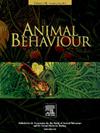The effect of competitor presence on the foraging decisions of small mammals
IF 2.3
2区 生物学
Q2 BEHAVIORAL SCIENCES
引用次数: 0
Abstract
Competitive interactions between species can have marked effects on the diets and foraging behaviours of the interactants. Dominant competitors can constrain the foraging decisions of subordinate competitors, reducing the individual fitness of subordinates and potentially driving their populations to low levels. Following a sustained population decline of the bush rat, Rattus fuscipes, in the presence of the competitively dominant common brushtail possum, Trichosurus vulpecula, at Booderee National Park in south-eastern Australia, we investigated whether possums affected the foraging decisions of bush rats. Using a manipulative feeding experiment, we predicted that bush rats would (1) increase visits to baited sites where possums had restricted access to the bait and (2) restrict visits to baited sites where possums had free access. We used camera traps to investigate visit patterns and time spent foraging at 40 baited sites with two treatments, one that allowed full access by both species (full access) and the other that attempted to prevent possum access (restricted access). We also measured additional covariate factors that may influence visits. Bush rats visited both treatments less when there were more possum visits. We also found that bush rats spent less time eating bait at sites regularly visited by possums, regardless of possums’ access level. Our results indicate that negative interactions, such as competition, can restrict the ability of subordinate species to successfully forage, contributing to species declines.
竞争者存在对小型哺乳动物觅食决策的影响
物种之间的竞争性相互作用对相互作用者的饮食和觅食行为有显著的影响。优势竞争对手可以约束下级竞争对手的觅食决策,降低下级竞争对手的个体适合度,并可能使其种群降低。在澳大利亚东南部的Booderee国家公园里,由于普通帚尾负鼠(Trichosurus vulpecula)的竞争优势,丛林鼠(Rattus fuscipes)的数量持续下降,我们调查了负鼠是否会影响丛林鼠的觅食决策。通过操纵喂食实验,我们预测丛林大鼠会(1)增加对负鼠限制进入的诱饵地点的访问次数,(2)限制对负鼠自由进入的诱饵地点的访问次数。我们使用相机陷阱调查了40个诱饵地点的访问模式和觅食时间,并进行了两种处理,一种是允许两种物种完全进入(完全进入),另一种是试图阻止负鼠进入(限制进入)。我们还测量了可能影响访问的其他协变量因素。当负鼠来访次数增多时,布什老鼠对两种治疗方法的访问次数都减少了。我们还发现,无论负鼠的进入程度如何,丛林老鼠在负鼠经常光顾的地方吃诱饵的时间都更少。我们的研究结果表明,竞争等负面相互作用会限制从属物种成功觅食的能力,从而导致物种数量下降。
本文章由计算机程序翻译,如有差异,请以英文原文为准。
求助全文
约1分钟内获得全文
求助全文
来源期刊

Animal Behaviour
生物-动物学
CiteScore
4.60
自引率
8.00%
发文量
236
审稿时长
10.2 weeks
期刊介绍:
Growing interest in behavioural biology and the international reputation of Animal Behaviour prompted an expansion to monthly publication in 1989. Animal Behaviour continues to be the journal of choice for biologists, ethologists, psychologists, physiologists, and veterinarians with an interest in the subject.
 求助内容:
求助内容: 应助结果提醒方式:
应助结果提醒方式:


